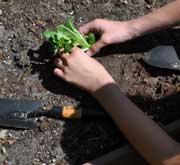By Avalon Theisen
.jpg)
Victory gardens were planted in World Wars I and II to supply fresh food at home because so much food was being sent to soldiers overseas. As the gardens grew, so did the people’s morale. Everyone was proud because they were doing something important for themselves and their communities. Even though we have plenty of access to food today, I have started learning about the benefits of growing my own food. Recently, I started my first garden. I am going to share some of what I have learned, and hope that you will start your own garden, too!
Edible gardens are very cool because they help you live more sustainably, which helps our planet. A lot of times, food travels from an unknown faraway place to your local store, and then you travel to the store to get it. Fuel is wasted and a lot of pollution is added to the environment. When you get food from your garden, you know exactly what is in it, with no need to worry about chemicals from fertilizers or pesticides. You will also know exactly where your food comes from! Having healthy food right outside your door means you will eat more vegetables and fruits. Gardening is a fun way to get exercise and enjoy the outdoors, which means having less stress which is very helpful for all ages. Topping these benefits off, supplying some of your own food saves your family money!
One thing you need to think about is what kind of space you have for your garden. You can do your planting pretty much anywhere but a sunny or partially sunny spot is best. If you have a patio or balcony, flower pots may fit perfectly. Digging up part of your lawn for planting or installing a raised bed garden will work great for larger spaces.
Now that you have your space, what are you going to plant? If your parents always had a garden somewhere north, they’ll need to rethink everything they know to be successful in Florida. Plants like traditional lettuce and greens do best in the winter but you can plant food like currant tomatoes, yard-long beans, or sweet potatoes and portulaca (summer greens for Florida) to have fresh vegetables year-round. (Learn more at the University of Florida’s IFAS site online at http://edis.ifas.ufl.edu/vh021 or contact your local extension service for hands-on advice from experienced gardeners.)

You can get started with seeds, clippings (a cut-off part of an existing plant) or store-bought plants. Some food scraps, like the base of lettuce or celery, can also grow new plants. Some of my starter plants are pumpkin (seeds), cranberry hibiscus (clippings), tomatoes (store-bought) and lettuce (food scraps).
Two eco-friendly things to help your garden grow are composting and rain-water collection. In my last column, Pounds to Ounces: The Zero-Waste Project, I wrote about how I was learning to keep trash and food scraps out of the landfills, by recycling and composting. If you do not already compost, which is basically recycling organic matter, you might like to read the information I shared, because it can help you get started. Collecting rain water in rain barrels or other containers means saving your local water supply.
No matter where you live, you can grow your own food. I really enjoy watching my garden grow, and supplying some of our salad ingredients! If you decide to grow your own garden, I would love for you to share your story and pictures with me at ConserveItForward@verizon.net.
[su_divider]
Originally published Winter 2013